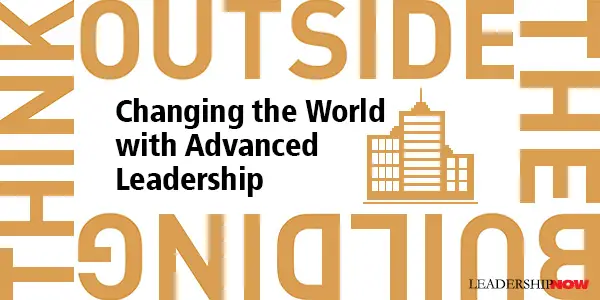 |
 |
02.14.20

Think Outside the Building
SYSTEMIC SOCIAL ISSUES cannot be solved by a few people working in isolation. They can be better addressed by breaking out of traditional approaches and collaborating with others. Rosabeth Moss Kanter likens these traditional approaches to castles. In Think Outside the Building, she writes, “Castles are any set of institutional structures that loom large and feel permanent. Castles are monuments to the past and to past thinking, museums of preservation.” Moving outside of these castles is the beginning of innovation. For example, “health is equated with hospitals, education with schoolhouses, news with newspapers, spirituality with the church, a city with city hall.” And we look to these institutions for solutions. But the solutions lie outside the “castle.” Health isn’t the hospital or even the doctor’s office. Health might be a function of nutritious food, clean air, or stress-free work. But behemoth establishments dominate health care, including rival fiefdoms such as providers and insurance companies, full of fortification and defenses, sometimes shutting out alternatives for treatment or blocking routes to wellness. The same can be said of educational systems, city governments, and other institutions that we look to for answers. Kanter says the best way to deal with these entrenched systems is not to attack them head-on, but to go around or under, or even start something new that is so attractive that others flock to it. Advanced Leadership To encourage this kind of action, professors Kanter, Rakesh Khurana, and Nitin Nohria co-founded the Harvard Advanced Leadership Initiative as a third level of education to bring together experienced leaders who could then go and address some of the world's most challenging problems. But the Advanced Leadership is not specifically about older, more experienced people, but a level of thinking that takes leaders of any age, out of the building, “beyond boundaries, across silos, and outside established structures.” Advanced Leadership is a different mindset than single-minded leadership furthering its own goals within a single organization. “Complex, messy, ambiguous, contentious institutional problems require more of leaders than exercising the authority inherent in their roles; they take entrepreneurial hustle. That also requires a larger pool of leaders willing and able to tackle them.” We need more Advanced Leaders. Kaleidoscope Thinking A different kind of thinking—kaleidoscope thinking—is required. “Creativity is a lot like looking at the world through a kaleidoscope. Innovators shake up their thinking as though their brains are a kaleidoscope, permitting an array of different patterns out of the same bits of reality. Leaders who take on big, intractable systems problems must be able to break out of prevailing wisdom in order to move beyond it. The fragments of your kaleidoscope as built over time. Experiences, frustrations, and observations waiting to be connected when the time is right. Digital innovator John Taysom said, “Dream your worst nightmare, then invest in it,” or “see the thing that upsets you and use it as an opportunity for change.” Get out and experience the new and truly different to shake the kaleidoscope into new possibilities. “What differentiates advanced leaders from noninnovators is that they can see further because of their quality of preparation and attention. They zoom out to see the big picture; they tune in to the context and read the zeitgeist.” Advanced leaders are always looking. Look for what’s not there. Look for the gaps. Advanced leaders must learn to tell a different story in order to gain support. “If you don’t like how things are going and want to lead change, tell a different story.” Reframe the problem to illuminate possibilities. Stories can’t be fairy tales. Narratives should be evidence-based, meeting a plausibility test. Marshalling the evidence sometimes requires creating new evidence through pilot programs—something that people can see and touch, something that has “street cred” (visible on the street. Prototypes are fundamental. Kanter explains the need, the process, and the trials of advanced leadership in the face of “castles” through example after example of those who are outside the building trying to make a difference. It is an instructive and inspiring book. It is a call to action into the unknown with a distinguished guide. The nature of change challenges, whether inside corporate offices or beyond the walls, increasingly requires more than traditional hierarchical leadership skills guiding teams inside the building; the new challenges require advanced leadership. For institutions that are threatened with disruption and displacement, this kind of leadership is essential because they simply can’t keep singing variations of the same old refrains with a digital note added here or there. And as the routinized parts of jobs are replaced (or augmented) by technology, increasing numbers of people will find themselves working on tasks outside the building. 
Posted by Michael McKinney at 06:48 AM
|
BUILD YOUR KNOWLEDGE
 

How to Do Your Start-Up Right STRAIGHT TALK FOR START-UPS 
Grow Your Leadership Skills NEW AND UPCOMING LEADERSHIP BOOKS 
Leadership Minute BITE-SIZE CONCEPTS YOU CAN CHEW ON 
Classic Leadership Books BOOKS TO READ BEFORE YOU LEAD |